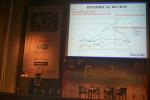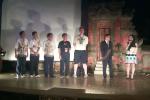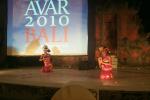First published: 27th November 2010
Billed as the "Conference in Paradise", the 13th Anti-Virus Asia Researchers (AVAR) International Conference took place in the lush surroundings of the Grand Hyatt Nusa Dua resort in Bali from the 17th to 19th of November. With thirty papers presented, lazing by the pool took second place to focussed attention in the cool darkness of the conference hall.
The conference had two streams, so not all speakers are reported on here.
In his keynote, Mikko Hyppönen reviewed the development of malware over the last quarter-century (that is something to consider, the first PC virus, Brain, was probably written in December 1985), and showed the deficiencies in our approach. The "State of the Net" is getting worse, the security industry is failing to combat the increase in malicious software and spam. Our solutions are targeting the symptoms, we need to target the criminals. As has been said before, early malware was written by people wanting to attract attention or prove how clever they were, the biggest change has been the increasing involvement of criminals motivated by personal monetary gain. This leads to malware that does not advertise its presence, and a criminal organisation with different parties taking very specific roles. The software development is highly professional, as can be seen by the boot sector infector Mebroot, that appeared in 2008: if an infected computer crashes, Mebroot will take a diagnostic dump and send it to the developers, presumably so that they can identify whether Mebroot caused the problem, and work out how to prevent it in the next version. How many commercial software development teams are that professional? There may also be a more dangerous side: the large, Ukrainian website hosting company, Hosting.UA, suffered a large data-centre fire in March 2010, shortly after kicking out a dozen illegal sites. Coincidence or retaliation? Certainly, the criminal organisations have successfully monetised malware, so extreme methods of protecting their investment are possible. Mikko finished with two other areas that will be significant in future. Mobile phone malware has been tiny so far, but it is easier to make money infecting phones, so we can expect this to grow. Secondly, Stuxnet is a seminal event, it kills the principle that your security does not need to be perfect, only better than other potential targets. It also reached "unreachable" systems, via USB devices, involved multiple man-years of development and was missed by anti-virus developers for perhaps a year. The resources, sophistication and style of the attack point to Nation State involvement, but there will be copy-cats.
Peter Wei took a look at security in the "Internet of Things" (IoT), where RFID, IPv6 and EPC (the Electronic Product Code, a replacement for the UPC barcodes) are major enablers. Peter noted that security and privacy in these systems are usually very weak, and considered add-on features, leading to information leakage and other attacks. Very often, the back-end systems can be targeted by SQL-injection attacks from rogue tags. He proposed a three-way authentication model between the tag, reader and service provider and cloud-based malware detection, and that these should be considered in the architecture design of the systems.
Roel Schouwenberg warned us that Adobe is currently the most exploited software in the world and identified the key issues leading to this. Many people are not updating their Adobe Reader - recent successful attacks used exploits that were three years old! The Adobe Reader itself, and many alternative parsers, do not follow the formal specifications, for example, they will load a "secure" PDF that has been tampered with. There is no API for hooking into Adobe's script parser, complicating the task for anti-malware developers who therefore need to "reinvent the wheel" before they start to try to detect and identify malware. The Adobe Reader runs in a Limited Account, but the Adobe Updater, launched by the Reader, has full system privileges and therefore offers another opportunity to the attacker. However, there are some positive developments. Many in-the-wild PDF malware do not run in Windows 7, so they will probably disappear. Adobe is introducing a sandbox, with DEP and ASLR, but its success will depend on how good the implementation is.
Cristian Lungu explained the Rise of Icon attacks as a form of social engineering exploiting the user's association of a icon with a program. The percentage of malware families using an icon has risen from less than 50% in October 2008 to almost 70% in June 2010. The icons most often used are from Office tools, Games, Windows environment and System tools. However, identifying mis-use of icons is not simple as malware frequently uses slightly modified versions of familiar icons. Icon comparison is a useful heuristic for malware because, however many packing layers the file may have, the icon remains the same so that the user can be tricked. Therefore, a slightly modified version of a common icon is a good marker for malware.
Kyu-Beom Hwang talked about fileless whitelisting and false positive testing, describing his company's development of a virtual whitelist that identifies files using a block-crc-entropy value and addresses the difficulties of collecting clean whitelist samples. Also on the theme of false positives, Mark Kennedy explained how AMTSO (Anti Malware Testing Standards Organization) had studied the issue of testing for false positives in traditional products and cloud-based services.
Narendra Kumar reported on the development of algorithmic detection for metamorphic viruses based on a semantic signature.
Scott Molenkamp analysed the performance of malicious managed downloaders, often used to monetise malware by "pay per install" affiliate programmes. The proliferation of pay per install schemes and commission sharing creates a demand for configurable software that facilitates and simplifies botnet management. Typically, the tools come with an end user agreement that disclaims responsibility and specifies they should only be used for "research" purposes, but the pricing and prevalence of the tools make innocent use an unlikely explanation. In the questions to the session, the possibility of attacking the pay per install infrastructure by faking millions of downloads with the intention of crashing the market and destroying the trust between criminals was raised.
Wei Yan reported on government/industry cooperation in China, and concluded that we achieve the best security results when governmental policies and regulations are well aligned with the underlying science and practice.
Igor Muttik discussed the different forms of cooperation within the anti-malware industry, including through CARO, EICAR, AVED, VMacro, AMTSO, AVAR, VB and IEEE ICSG. He concluded that, in the face of the rising number rising sophistication and targeting of attacks, cooperation among the good guys is essential.
In their combined presentation, David Harley, Lysa Myers and Eddy Willems covered the issues surrounding malware simulation and testing, the limitations of the EICAR test file, and extensions of the concept.
As a replacement presentation, Rand Abrams expounded on endpoint security, whatever the endpoint may be, and how anything from medical devices through card key readers and routers to business centre computers may be the malware endpoint and the critical area for exposure of sensitive information.
Rajesh Nikam reported on behaviour-based detection of file infectors.
Evgeny Smimov described analysis to extract obfuscated text from image spam.
Stefan Tanase discussed recent targeted attacks, including Aurora and Stuxnet, and their implications. Not only did these events demonstrate the power of targeted attacks, they changed a major corporation's approach to a region (Google's to China), and they were probably discovered after they had been successful in their objectives. They also have advantages over general attacks: if there is a corporate monoculture in the target, they only have to bypass the target's AV. Most corporate networks are focussed on external threats: the eggshell model. Once inside, the attack can work over a period of time undisturbed before exporting all the valuable data in one burst, probably at a weekend when the administrator will be slow to react. Stefan concluded that a security mindset is important. Stefan was voted Best Speaker by the participants.
The final session was a panel session on "Rogue, Anything Rogue", chaired by Righard Zwienenberg, with Andrew Lee, Lysa Meyers, David Harley and Tony Lee. The panel explained some of the many tricks used by rogue anti-malware applications and the consequences. There are also issues in how to define what are legitimate and rogue applications, and possibilities of sleeper applications that, maybe, work as advertised for six months, then go bad. It is all about awareness, as internet penetration spreads the next billion users will be new, naïve targets for the criminals. There is also the younger generation, the "digital natives", who are growing up with this technology, to be made aware.
The Gala Dinner, always a highlight of the AVAR Conference, was notable for two firsts. It was held outdoors, under the tropical moon, and the entertainers choreographed a traditional Balinese dance for the conference, showing the triumph of the wise Mr. AVAR over the demon Trojan.
 Approaching the conference hall hi-res
Approaching the conference hall hi-res Peter Wei and the 'Internet of Things' hi-res
Peter Wei and the 'Internet of Things' hi-res Kyu-Beom Hwang and the False Positive Crisis hi-res
Kyu-Beom Hwang and the False Positive Crisis hi-res Sei Murakami thanks the conference organisers at the Gala Dinner hi-res
Sei Murakami thanks the conference organisers at the Gala Dinner hi-res Gala Dinner entertainment hi-res
Gala Dinner entertainment hi-res AVAR Balinese Dance: The demon Trojan tries to hide hi-res
AVAR Balinese Dance: The demon Trojan tries to hide hi-res AVAR Balinese Dance: Having vanquished the demon Trojan, Mr. AVAR introduces the clean software hi-res
AVAR Balinese Dance: Having vanquished the demon Trojan, Mr. AVAR introduces the clean software hi-res Bali hi-res
Bali hi-res